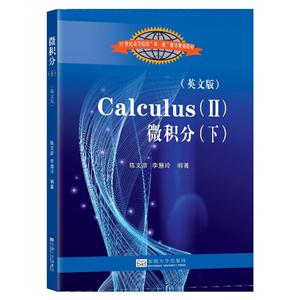扫一扫
关注中图网
官方微博
本类五星书更多>
-
>
宇宙、量子和人类心灵
-
>
气候文明史
-
>
南极100天
-
>
考研数学专题练1200题
-
>
希格斯:“上帝粒子”的发明与发现
-
>
神农架叠层石:10多亿年前远古海洋微生物建造的大堡礁
-
>
声音简史
微积分(下英文版21世纪高等院校双一流建设规划教材) 版权信息
- ISBN:9787564192310
- 条形码:9787564192310 ; 978-7-5641-9231-0
- 装帧:一般胶版纸
- 册数:暂无
- 重量:暂无
- 所属分类:>
微积分(下英文版21世纪高等院校双一流建设规划教材) 内容简介
本书是根据国家教育部非数学专业数学基础课教学指导分委员会制定的工科类本科数学基础课程教学基本要求,并结合东南大学多年教学改革实践经验编写的全英文教材。全书分为上、下两册,此为下册,主要包括级数、向量代数与空间解析几何、多元函数微分学、多元函数积分学、向量场的积分等五部分。本书对基本概念的叙述清晰准确,对基本理论的论述简明易懂,例题习题的选配典型多样,强调基本运算能力的培养及理论的实际应用。本教材的内容是工科学生**大学数学知识。利用英文编写更有利于学生提高与国际同行专家交流的能力。
微积分(下英文版21世纪高等院校双一流建设规划教材) 目录
Chapter 5 Infinite Series
5.1 Convergent Series
5.1.1 Concepts of Convergent Series
5.1.2 Properties of Convergent Series
5.2 Tests of Convergence and Divergence
5.2.1 Tests for Positive Series
5.2.2 Alternating Series
5.2.3 Absolute and Conditional Convergence
5.3 Tests for Improper Integrals
5.3.1 Improper Integrals: Infinite Limits of Integration
5.3.2 Improper Integrals.Infinite Integrands
5.3.3 The Gamma Function
5.4 Infinite Series o{ Functions
5.4.1 General Definition
5.4 .2 Uniform Convergence of Series
5.4.3 Properties of Uniformly Convergent Functional Series
5.5 Power Series
5.5 .I The Radius and Interval of Convergence
5.5.2 Properties of Power Series
5.6 Expanding Functions into Power Series
5.7 Fourier's Series
5.7.1 The Concept of Fourier's Series
5.7.2 Fourier's Sine and Cosine Series
5.7.3 Expending Functions with Arbitrary Period
Chapter Review Exercise
Chapter 6 Vectors and Analytic Geometry in Space
6.1 Vectors and Their Linear Operations
6.1.1 The Concept of Vector
6.1.2 Linear Operations on Vectors
6.1.3 Dot Product and Gross Product
6.2 Operations on Vectors in Cartesian Coordinates in Three Space
6.2.1 Cartesian Coordinates in Three Space
6.2.2 Operations on Vectors in Cartesian Coordinates
6.3 Planes and Lines in Space
6.3.1 Equations for Plane
6.3.2 Lines
6.3.3 Some Problems Related to Lines and Planes
6.4 Curves and Surfaces in Space
6.4.1 Sphere and Cylinder
6.4.2 Curves in Space
6,4.3 Cone
6.4.4 Surfaces of Revolution
6.4.5 Quadric Surfaces
6.5 Vector-Valued Functions
6.5.1 Limit of a Vector-Valued Function
6.5.2 Derivative of a Vector-Valued Function
6.5.3 Integral of a Vector-Valued Function
6.5.4 Curvilinear Motion
6.5.5 Curvature
Chapter Review Exercise
Chapter 7 Multivariate Functions and Partial Derivatives
7.1 Functions of Several Variables
7.2 Limits and Continuity
7.3 Partial Derivative
7.3.1 Definitions of Partial Derivative
7.3.2 Geometric Interpretation of Partial Derivative
7.3.3 Second Order Partial Derivatives
7.4 Differentials
7.5 Rules for Finding Partial Derivative
7.5.1 The Chain Rule
7.5.2 Implicit Differentiation
7.6 Directional Derivatives and Gradient Vectors
7.6.1 Directional Derivatives
7.6.2 Gradient Vectors
7.7 Geometric Applications of Differentiation of Functions of Several Variables
7.7.1 Tangent Line and Normal Plane to a Curve
7.7.2 Tangent Plane and Normal Line to a Surface
7.8 Taylor's Formula for Functions of Two Variables and Extreme Values
7.8.1 Taylor's Formula for Functions of Two Variables
7.8.2 Extreme Values
7.8.3 Absolute Maxima and Minima on Closed Bounded Regions
7.8.4 Lagrange Multipliers
Chapter Review Exercise
Chapter 8 Multiple Integrals
8.1 Concept and Properties of Integrals
8.1.1 Concept of the Multiple Integrals
8.1.2 Properties of the Multiple Integrals
8.2 Evaluation of Double Integrals
8.2.1 Double Integrals in Rectangular Coordinates
8.2.2 Double Integrals in Polar Coordinates
8.2.3 Substitutions in Double Integrals
8.3 Evaluation of Triple Integrals
8.3.1 Triple Integrals in Rectangular Coordinates
8.3.2 Triple Integrals in Cylindrical and Spherical Coordinates
8.4 Line Integrals with Respect to Arc Length
8.5 Surface Integrals with Respect to Area
8.5.1 Surface Area
8.5.2 Evaluation of Surface Integrals with Respect to Area
8.6 Application for the Integrals
Chapter Review Exercise
Chapter 9 Integration in Vector Fields
9.1 Vector Fields
9.2 Line Integrals of the Second Type
9.2.1 The Concept and Properties of the Line Integrals of the Second Type
9.2.2 Calculation
9.2.3 The Relation between the Two Line Integrals
9.3 Green's Theorem in the Plane
9.3.1 Green's Theorem
9.3.2 Path Independence for the Plane Case
9.4 The Surface Integral for Flux
9.4.1 Orientation
9.4.2 The Conception of the Surface Integral for Flux
9.4.3 Calculation
9.4.4 The Relation between the Two Surface Integrals
9.5 Gauss's Divergence Theorem
9.6 Stokes's Theorem
Chapter Review Exercise
Solutions to Selected Problem
展开全部
微积分(下英文版21世纪高等院校双一流建设规划教材) 作者简介
陈文彦,东南大学数学学院教授、博士、硕士生导师。主要研究方向:非线性偏微分方程,近五年来,发表SCI论文10余篇。主持完成1项国家自然科学基金(2007.1-2009.12)。参与完成国家自然科学基金和江苏省自然科学基金各1项。2009年参加的几类非线性偏微分方程的研究获教育部颁发的国家自然科学奖二等奖(排名第四),2013年获江苏省级教学成果一等奖(排名第二)。主讲高等数学、数学物理方程、拓扑学、复变函数和线性偏微分方程等课程。
书友推荐
- >
有舍有得是人生
有舍有得是人生
¥25.7¥45.0 - >
姑妈的宝刀
姑妈的宝刀
¥15.7¥30.0 - >
月亮虎
月亮虎
¥15.4¥48.0 - >
【精装绘本】画给孩子的中国神话
【精装绘本】画给孩子的中国神话
¥18.6¥55.0 - >
中国人在乌苏里边疆区:历史与人类学概述
中国人在乌苏里边疆区:历史与人类学概述
¥21.6¥48.0 - >
烟与镜
烟与镜
¥18.3¥48.0 - >
推拿
推拿
¥12.2¥32.0 - >
二体千字文
二体千字文
¥14.0¥40.0
本类畅销
-
数学的魅力;初等数学概念演绎
¥9.4¥22 -
普林斯顿微积分读本-(修订版)
¥62.4¥99 -
高等几何
¥8.8¥20 -
离散数学(第六版)
¥43.4¥49.9 -
偏微分方程
¥20.9¥33.7 -
数学·统计学系列二维.三维欧式几何的对偶原理
¥96.6¥138
浏览历史
新常态下中国影子银行体系对金融稳定性和实体经济的影响
¥21.8¥52.0磁性器件的优化设计及其可视化算法
¥103.7¥128.0理论工作者的高等微分几——纤维丛、射流流形和拉格朗日理论(英文)
¥43.2¥68.0小淑女
¥10.3¥25.0OCDMA网络原理及应用
¥58.1¥168.0

















